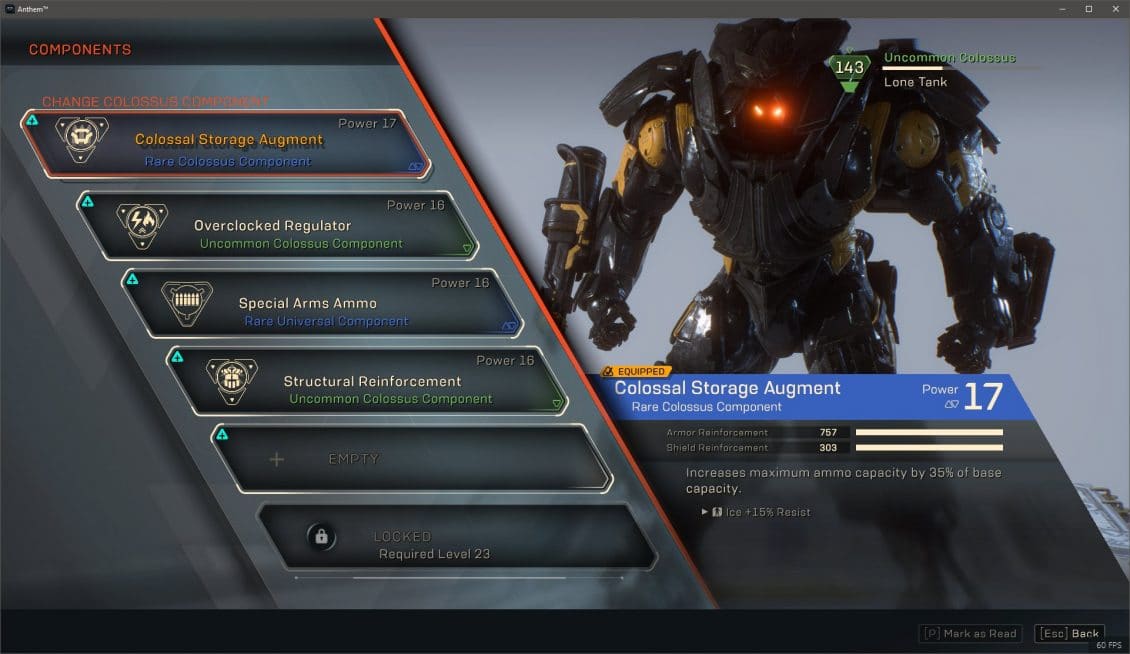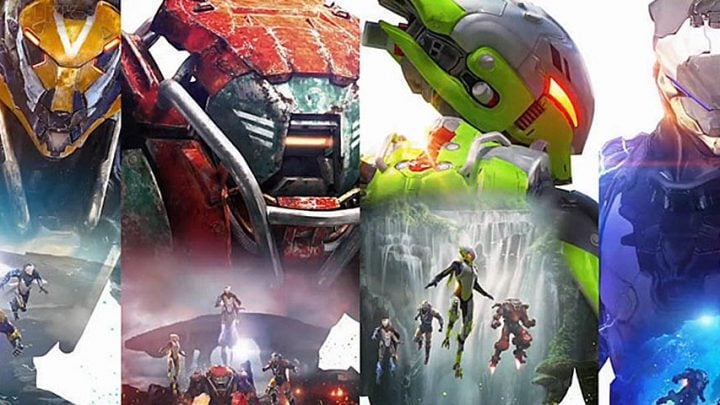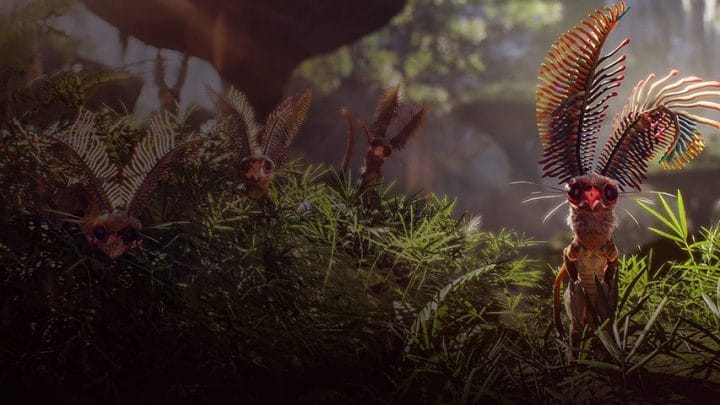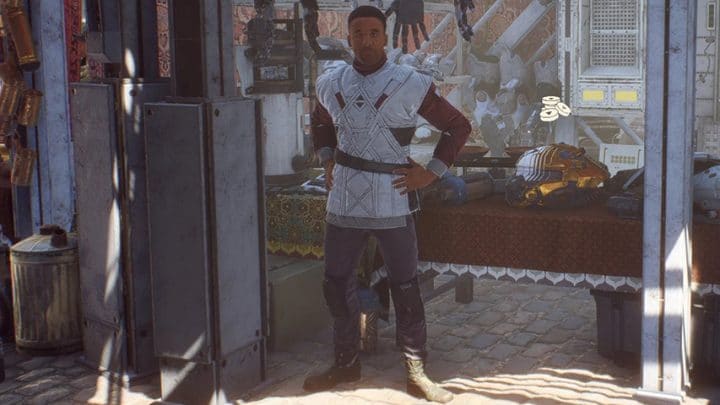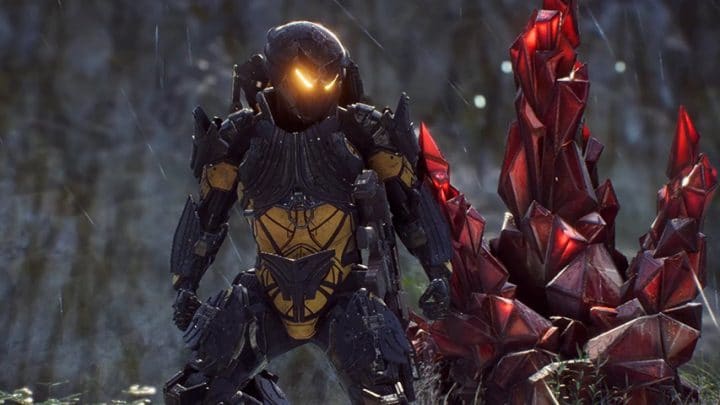Anthem’s appearance system turned out to be a very impressive by design. The Gearing segment doesn’t fall short to that at all! Let’s take a closer look!
BioWare’s Anthem is a game that obviously wants to cater to as many types of players as possible. After we’ve learned how Appearances in Anthem are going to work, today it’s time to check out the other half of the progression – gearing up, builds and what are the factors that directly benefit your javelin’s performance in combat.
When you are in the Forge (the Javelin modification station inside Fort Tarsis and Launch Bay), you will be able to modify a ton of things on your exosuit. In this article I’ll focus your attention on the Loadout sub-menu. Here is where you will make your tweaks to the javelin’s gear, weapons and other components.
LEVEL PROGRESSION
Your javelin has no levels. Everything is based on your Pilot level. As you play the game, complete missions and earn XP, you will be leveling your Pilot.
Everything that you loot in the game will have a level (Power). Those are the Pilot levels. When you craft something, it will be automatically crafted at the level of your Pilot. By the way, this is a good decision, because if you find a good schematic of a weapon, component or something else, you will always be able to craft from it something that will be ready for use at your current level.
To unlock blueprints of items, you need to play the game, complete achievements (challenges), missions, gain faction reputations and exploration. Different blueprints and sigils (sigils are the blueprints for consumables) are locked behind different “grind” elements. Each rarity blueprint must be unlocked before you are able to craft an item of that tier of rarity.
When you start the game, you will not have access to all gear slots of your Javelin. In fact, you will start with just one Javelin exosuit – the Ranger. As you complete missions, you will unlock more suits and gear slots for them.
At low level it will be extremely hard or rare for you to loot an item of a higher rarity rating. As you gain Pilot levels, you will start seeing more Uncommon items, then Rare and so on. Choosing to play at higher difficulty will also increase the chance of higher quality items dropping for you.
Here is a rough guideline of what items drop at what levels, while you progress towards the end-game:
- Levels 1 to 10 – Common and Uncommon (Green) Items
- Levels 11 to 20 – Uncommon and Rare (Blue) Items
- Levels 21 to 30 – Rare and Epic (Purple) Items
- Level 30 – Masterwork with a small chance for a Legendary Item on higher difficulties
These, of course, are not guaranteed and you are likely to get the first rarity in each category rather than the second. You will always be getting white trashy common items. You can freely dismantle them to get crafting components and free up inventory space.
Here is the table with rewards for gaining pilot levels from 1 to 30:
- Level 2: Unlock your first Javelin. Can be any of all available
- Level 3: Unlock a secondary Weapon Slot in Loadouts tab
- Level 4: Unlocking the first Component Slot in Loadouts tab
- Level 5: Unlocking the Support Slot in Loadouts tab
- Level 6: Unlocking the second Component Slot in Loadouts tab
- Level 8: Unlock your second Javelin. Can be any of all available
- Level 10: Unlock your first Consumable Slot at mission start screen
- Level 12: Unlocking the third Component Slot in Loadouts tab
- Level 14: Unlocking the fourth Component Slot in Loadouts tab
- Level 16: Unlock your third Javelin. Can be any of all available
- Level 18: Unlocking the fifth Component Slot in Loadouts tab
- Level 20: Unlock your second Consumable Slot at mission start screen
- Level 23: Unlocking the sixth Component Slot in Loadouts tab
- Level 26: Unlock your fourth Javelin. Can be any of all available
- Level 30: Unlock your third Consumable Slot and Grandmaster Difficulties
ITEM RARITIES, STATS AND COMBOS
Loot in Anthem is personal. You cannot trade or purchase from other players. Also each piece of item that you loot has a rarity level. There are six rarities in total in Anthem:
- Common (white)
- Uncommon (green)
- Rare (blue)
- Epic (purple)
- Masterwork (orange)
- Legendary (yellow)
It’s also important to establish some terminology frames:
- Weapon – the physical weapon of your javelin, the items that go on the main and secondary weapons.
- Gear Piece – an item that can be used as an active ability to cause damage. Each javelin has three unique gear slots – two damaging abilities and one support slot.
- Components – more on those below, but in short these are mods that boost certain stats of yours.
Each gear piece has three base stats – damage, recharge and (some times) Elemental status. The first two are well-known. It’s the third one that I want to talk more about. it’s a new type of stat that shows how quickly you would (in this case) light someone up and put them on fire. The gear in the image was a Flamethrower that goes on the Heavy Assault Launcher gear slot of the Colossus and is unique to that exosuit. The type of elemental effect could be different – Ice, fire, poison, electricity.
This is important for the combo system in Anthem. If you have played any of the Mass Effect games, you know how combos work. In short – you use one skill on a target to prime it for a combo, then you or a teammate of yours uses a special detonate type of ability that activates the combo. Each ability has its own effects, but when they are combined together, you get something extra. It could be a bigger damage, wider area of effect, elemental effect, explosion etc.
The higher the “Fire Status” rating is, the quicker you will be able to prime your target for a combo.
Below are two images showing what the icons for Primer and Detonator look like in Anthem.
Primer
Detonator
Note, they have been changed and updated between the Demo and the Early Access. On some images here as well as all over the internet, you might still be seeing the old ones – a circle with a leaf for Primer and a flame for Detonator.
Below the stats block, is the inscription block. Here you will see a certain amount of bonus perks. They are usually drawn from a large pool of available perks, based on your level, javelin and difficulty you play on. The higher the rarity of the item, the more and better inscriptions you will get.
There are two small grey images in front of each inscription on items with inscriptions. The icons clarify the effect these perks will have on your build:
- Human Figure – means that the inscription with this icon in front of it affects your whole Javelin and all of its abilities and slots.
- Cog (Gear Icon) – means t hat the inscription with this icon only affects this single item it is attached to and not the whole Javelin build.
If you are not happy with the set of inscriptions on a crafted item, simply craft another one (if you have the resources). If the item is looted, go do more missions or repeat the same one to loot another version of the same item. It’s a high chance that the inscriptions will be different and if you are lucky – even better. Based on the rarity of the item, you can have between one or four inscriptions. All drawn randomly from different pools of perks. The downside is that here RNG is going to play a huge role, unfortunately.
Masterwork and Legendary items come with a special Masterwork property. This is an additional bonus or effect that is added to your item. On the image above the Masterwork property is marked with the Orange text.
The Special Property is the same each time you craft or loot the same item. However, the Inscriptions will be different.
The difference between Masterwork and Legendary tier of rarity are in the values of the bonuses. A Legendary item will have better and stronger power and stats compared to the same version of the item in its Masterwork rarity. At launch they cannot be crafted, only earned through gameplay (loot).
DAMAGE TYPES IN ANTHEM
There are two main types of damage in BioWare’s Anthem: Physical and Elemental. They both split up further into sub-categories. Physical can be Impact or Acid. Elemental can be Fire, Ice or Electrical.
Impact is the damage type of guns typically. Abilities, which damage is marked with a small diamond-shaped icon infront of the value, are also Impact. This is not necessarily a single target damage, it’s just a type of a physical damage. Acid, as weird as it may be, is not an elemental damage, but physical as well. All modifiers in the game that mention Impact, talk about these types of damages. Acid makes the target take more damage.
The Elementals have each a different effect on the target and are for the most part primer abilities. They are also stronger or weaker against different types of enemies (shielded and armored). Electrical damage makes the target stagger and also turns it into a conduit – spreading the electrical effect on other targets. This doesn’t do much of damage on the additional targets, but it primes them for a combo. Fire places the target on fire (burning damage over time). Ice freezes opponents in place or slows them down. Fire and Ice contradict each other and cancel each other’s effects.
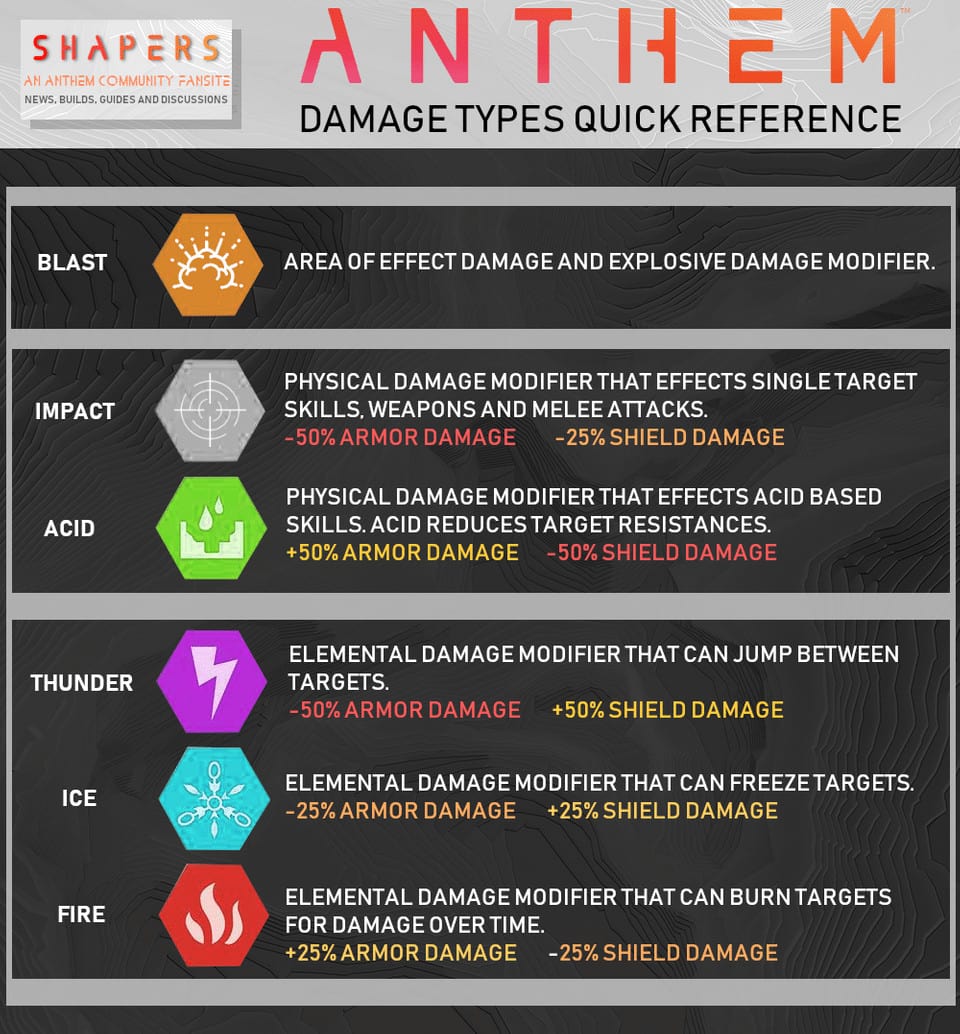
As you can see on the image above, each Elemental has advantages and disadvantages against certain types of enemies. If you want to have a strong build against armored opponents, for example, you would want to have Impact, Fire and Acid on your side. To take the shielded Scar snipers (for example) quick, you would want to hit them with Ice and and Electrical. Anthem is a group-based game and you are always better off going to an expedition with a friend. It is even better if you two build your javelins accordingly to benefit each other.
Blast is a component that does not fall into a category of the already mentioned above. It is usually an AoE damage type. It can be an elemental or physical.
Armored opponents can be primed and detonated. Some enemies, such as the little annoying scorpions, have thick armor and are classed as armored, despite the fact that they appear with a red HP bar. The typical symbol for armored enemies are Yellow.
Shielded enemies have a blue bar on top of the red HP bar. You cannot crit through shields, but can still detonate a combo through it if the target was primed already when it got their shield back up. If, for example, your weapon has a “hit-streak weak spot bonus perk (Masterwork and Legendaries some times have these added properties as as I stated earlier in this article), hitting the weak-spot will still trigger the bonus from the weapon, even though your damage appears white.
JAVELIN GEAR SLOTS
If you remember from my Anthem Classes and Abilities Guide, each javelin gets two weapons, and a support gear slot. But your Loadout has five slots in total. As you progress through the story and levels, you will unlock them all, plus an additional one for the story purpose. Let’s check them out one by one!
On the top left you see the two major sections:
- Appearance – this is where you can change outfits, skins and all sorts of the suit’s visual appearance. Whatever you do here wont affect your combat performance and stats.
- Loadout – here you can swap your the two weapons for each javelin, the support gear and components.
At the top right is your javelin stats window. Here you can see the item ratings of each element you have selected in the loadout and a total “gear score” stat. The last one is used by the devs to determine whether this or that piece of content is recommended for you at any given time. If your javelin has, for example, too low gear score for a certain mission, a warning might pop up notifying you that you risk a lot venturing forward.
Javelin’s Weapons
The Grenade (Ranger specific slot), Weapons and Support Gear are all things you can populate with abilities specific to the type of javelin you play. Each javelin class has specific weapon slots.
What are Components?
Usually in multiplayer games you would have gear pieces that bring you stats. In Anthem the gear pieces are actually used just for vanity – appearance and outfits.
To compensate for this, BioWare introduces the Components. Each Javelin has six slots for Components. These are special gear pieces that contain stat boosts and perks. They can even alter the behavior of some of your abilities in combat. They are unlocked gradually as you level up.
The components also have rarities and just like the weapons, have inscriptions. Unlike with the weapons, however, Components can only have up to two inscriptions, which are once again drawn randomly from specific pools of perks and bonuses. You can also craft Components yourself. They too require you to have the schematic first and also the specific crafting materials.
Consumables (Sigils)
These are items you can craft and use to increase a stat or event during your next mission. Each consumable can be used only once – hence the name.
The blueprints for Consumables are called Sigils and they are earned as you progress through the game and complete achievements.
Consumables can be universal or Javelin-specific. They also have the same rarities. Higher rarity requires equivalent amount of crafting materials from the same tier. You can equip those before you head out on your next expedition in the group preparations window.
Why must it be so complicated?
If it sounds confusing and weird that they have gone so deep with the customization, there are reasons for that – the higher difficulties will demand of you to have this specific build to be able to overcome a certain mission or even one single boss encounter. If you prefer to play casually, you don’t actually need to bother with customizing your gear to that extend. Simply populate the empty slots with whatever you have (or even leave them empty) and venture out in the world or on a mission by choosing a lower (lowest) difficulty.
Anthem lets you choose at first between three standard difficulty levels – Easy, Normal and Hard. The end-game (lvl 30) later unlocks three more tiers – Grandmaster 1, 2 and 3. There you will absolutely really need to tweak your build and gear if you want to survive. The rewards are worth it, though. The higher the difficulty, the better chance for rare items of higher quality to drop for you. While leveling, though, it may be faster and better if you don’t choose Hard. If you are a skilled Lancer, by all means, Hard will provide a decent challenge. However, this guide is aimed at beginner players and if you are one, the Hard Difficulty, while theoretically providing better XP and loot, will actually slow down your progress significantly due to the difficulty of each encounter.
This is all I have for you about Anthem Gearing and Progression… for now! This guide is frequently updated and expanded to answer all your questions and needs as BioWare updates and changes the game and its mechanics!
Anthem launched on February 22, 2019. Stay in the loop and follow Anthem’s updates with VULKK.com! Check out the NEWS and GUIDES section to learn more about the game and be ready for its launch!
ANTHEM Beginners Guides
Are you new to Anthem? Here you will find all the basics to help you get started! This Beginners Guides Collection is always up to date with the latest changes from BioWare!




